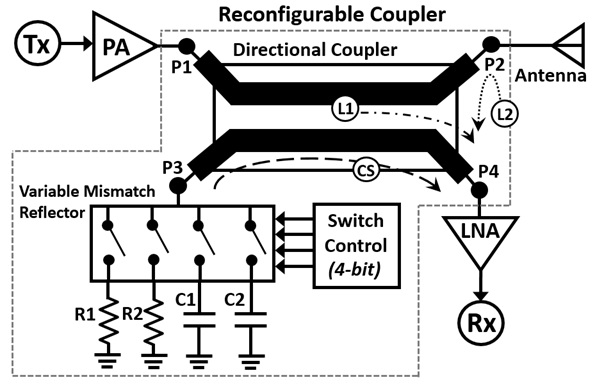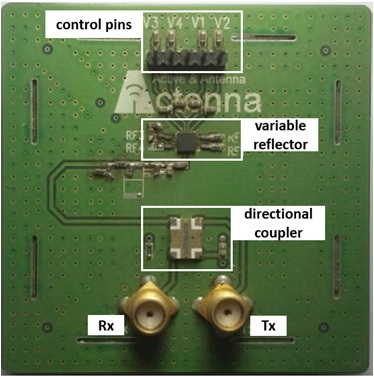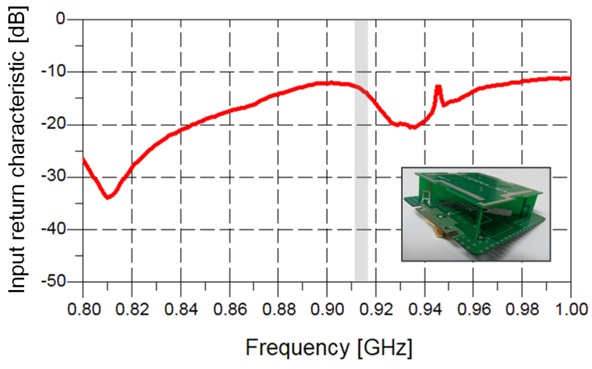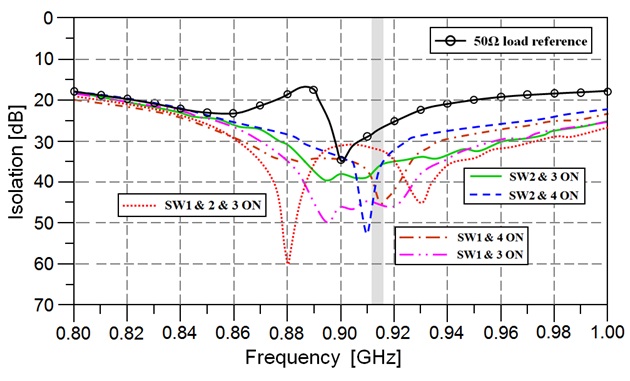



Radio-frequency identification (RFID) readers rely on the isolation characteristics of the Tx and Rx paths in the antenna front end, since the Tx leakage directly affects the Rx sensitivity. The bi-static architecture where Tx and Rx antennas are used separately can achieve high isolation characteristics, but this increases the system size and cost. Thus, a monostatic architecture is preferable in an RFID reader system, since it only requires a single antenna, thereby giving a smaller size and lower cost. The correct application of the monostatic architecture to an RFID reader requires resolution of the degradation in Rx sensitivity due to Tx.
Many studies have adopted the use of Tx leakage cancellers that are configured by a range of different structures, including multiple hybrid couplers [1], quadrature feedback circuits [2], variable attenuators, phase shifters controlled by micro-controller units (MCUs) [3], and single impedance mismatch reflectors [4]. However, these previously proposed structures impose a large size and design complexity to achieve the required leakage suppression. The architecture with a single impedance mismatch reflector also undergoes a limited range of Tx leakage cancellation due to the fixed impedance in the reflector. These limitations emphasize the need for a new type of reconfigurable coupler that can be used to suppress Tx leakage in a mono-static RFID reader front end with a simple implementation, as is proposed in this letter.
II. CIRCUIT DESIGN AND ANALYSIS
Fig. 1 shows the proposed reconfigurable directional coupler in the RFID front end. Referring to Fig. 1, Tx leakage generally consists of the coupled signal from the Tx port to the isolation port due to the intrinsic isolation characteristic of the directional coupler (
The values of Γ determine the cancellation of the Tx leakage flows to the Rx (port 4 of the directional coupler). That is, if multiple values for Γ can be generated according to the antenna impedance variations, then the Tx leakage can be cancelled regardless of the antenna load conditions.
Since determination of Γ depends on varying the antenna matching conditions by the circumstances of system usage, Γ must also be controllable according to the values of ΓA. As shown in Fig. 1, a SP4T switch is connected with different loads
The proposed reconfigurable directional coupler was implemented with a LTCC 10-dB directional coupler from RN2 Technology and a SP4T (MASW-007813) from MACOM. The discrete load impedances were implemented using
This letter describes a reconfigurable directional coupler that uses a variable impedance mismatch reflector to enhance the isolation characteristics. The variable impedance mismatch reflector could generate multiple reflection coefficients to cancel the Tx leakage, which varied according to the antenna load impedances. Setting the proper load impedance through the proposed reflector resulted in an improvement of more than 20 dB in the isolation characteristics at the RFID operation band.





